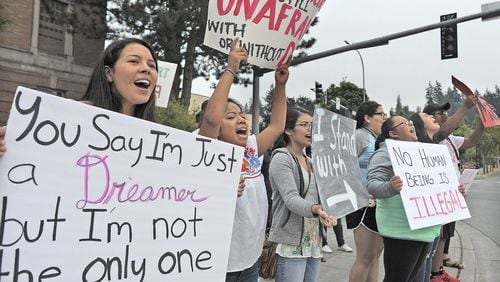President Donald Trump announced Tuesday that he was ending the Deferred Action for Childhood Arrivals program. But what do we know about these immigrants, especially the ones in Georgia?
The Department of Homeland Security released a report this year detailing the beneficiaries of the DACA program from 2012, when the program first started accepting applications, to March this year.
Nearly 800,000 young immigrants, who are referred to as Dreamers and were brought in illegally by their parents to states all over the U.S., received protection from deportation under the Obama-era initiative.
About 79 percent of them came from Mexico. Nine percent of them were from Central American countries – Costa Rica, El Salvador, Guatemala, Honduras and Nicaragua. In a statement, the president said DACA had caused a "massive surge in unaccompanied minors from Central America" and that some of these young people had gone on to join violent gangs such as MS-13.
To be sure, these numbers show how many DACA applications were approved. The authorities have received more applications, but approval may still be in process.
More than 200,000 of the young immigrants live in California. Georgia figures in the list of top 10 states for DACA population, with a little over 24,000 beneficiaries. DHS received 28,959 applications in total from Georgia during the same period.
DACA beneficiaries by state

222,795
California
124,300
Texas
42,376
Illinois
41,970
New York
32,795
Florida
27,865
Arizona
27,385
North Carolina
24,135
Georgia
22,024
New Jersey
17,843
Washington

222,795
California
124,300
Texas
42,376
Illinois
41,970
New York
32,795
Florida
27,865
Arizona
27,385
North Carolina
24,135
Georgia
22,024
New Jersey
17,843
Washington

222,795
California
124,300
Texas
42,376
Illinois
41,970
New York
32,795
Florida
27,865
Arizona
27,385
North Carolina
24,135
Georgia
22,024
New Jersey
17,843
Washington

222,795
California
124,300
Texas
42,376
Illinois
41,970
New York
32,795
Florida
27,865
Arizona
27,385
North Carolina
24,135
Georgia
22,024
New Jersey
17,843
Washington
Source: Department of Homeland Security
The Migration Policy Institute, a think tank based in Washington, estimates that, as of 2016, Georgia had about 73,000 people eligible under the DACA program. Again, a major share of them are Mexicans – about 65 percent – followed by Guatemalans and South Koreans.
DACA-eligible population by state

561,000
California
271,000
Texas
107,000
New York
102,000
Florida
96,000
Illinois
73,000
Georgia
71,000
New Jersey
66,000
North Carolina
52,000
Arizona
43,000
Washington

561,000
California
271,000
Texas
107,000
New York
102,000
Florida
96,000
Illinois
73,000
Georgia
71,000
New Jersey
66,000
North Carolina
52,000
Arizona
43,000
Washington

561,000
California
271,000
Texas
107,000
New York
102,000
Florida
96,000
Illinois
73,000
Georgia
71,000
New Jersey
66,000
North Carolina
52,000
Arizona
43,000
Washington

561,000
California
271,000
Texas
107,000
New York
102,000
Florida
96,000
Illinois
73,000
Georgia
71,000
New Jersey
66,000
North Carolina
52,000
Arizona
43,000
Washington
Source: Migration Policy Institute
Most of these immigrants reside in Clayton, Cobb, DeKalb, Fulton, Gwinnett and Hall counties.
DACA-eligible population in metro Atlanta counties

DACA-eligible population
5k
10k
15k
Hall
Fulton
Cobb
Gwinnett
DeKalb
Atlanta
Clayton

DACA-eligible population
Hall
5k
10k
15k
Fulton
Cobb
Gwinnett
Atlanta
DeKalb
Clayton

DACA-eligible population
5k
10k
15k
Hall
Fulton
Gwinnett
Cobb
DeKalb
Atlanta
Clayton
Source: Migration Policy Institute
What do we know about them?
In a report this year, the Migration Policy Institute also analyzed the education backgrounds and work profiles of the DACA population. It must be noted that one of the requirements to receive DACA protection is a high school education or its equivalent.
According to the analysis, nearly two-thirds of the DACA-eligible participants in 2014 were either enrolled in secondary school or had attained a high school diploma, but had not gone on to college.
The share of DACA population that had completed high school was higher than the share of the total U.S. population that had attained similar levels of education.
When it comes to employment, DACA-eligible workers made up 1.3 percent of the 48.9-million-strong labor force comprising workers ages 16 to 32 years old, the report found. What is worth noting is that DACA participants were more commonly found in white-collar jobs such as sales and office administrative jobs compared with DACA-ineligible unauthorized workers.
Nearly one-quarter of DACA participants had also enrolled in college while working, compared with one-fifth of U.S. workers who juggled a job and college studies in 2014.
About the Author







